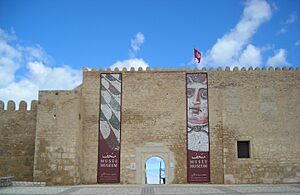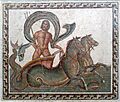Sousse Archaeological Museum facts for kids
| Musée archéologique de Sousse | |
 |
|
| Established | 1951 (reopen in 2012 after reorganisation of the collections and restoration of the building were completed) |
|---|---|
| Location | Sousse, Governorate of Sousse, Tunisia |
| Type | Archaeological museum |
| Collection size | Phoenician (Punic, Carthaginian), Roman, Byzantine, Christian |
The Sousse Archaeological Museum is a famous archaeological museum in the city of Sousse, Tunisia. It is known for holding one of the most amazing collections of ancient mosaics in the world.
Contents
A Museum Inside a Fortress
The museum is located inside the Kasbah of Sousse. A Kasbah is an old fortress that was built to protect the city. This one was built in the 11th century.
The museum first opened in 1951. It was later renovated and reopened in 2012 with newly organized exhibits. Its collection of mosaics is the second largest in the world, right after the Bardo National Museum in Tunisia's capital city, Tunis.
What Treasures Can You See?
The museum is filled with incredible objects from thousands of years ago. These artifacts tell the story of the people who lived in the area, from the ancient Phoenicians to the Romans and early Christians.
Amazing Mosaics
Mosaics are pictures made from tiny pieces of colored stone or glass. The museum has many famous mosaics that show scenes from old myths and stories. Some of the most famous ones include:
- Head of Medusa: A mosaic of the famous Greek mythological figure with snakes for hair.
- Face of Oceanus: A depiction of the ancient god of the sea.
- Neptune on his sea-chariot: Shows the Roman god of the sea, Neptune, riding a chariot pulled by sea-horses.
- A Nilotic landscape: A scene showing life along the Nile River in Egypt.
Ancient Punic Artifacts
Long ago, the area was part of the Punic civilization, also known as Carthage. The museum has items from this time, some dating back to the 7th century BC. You can see special urns and stone tablets called stelae that were used in religious ceremonies. Many of these were found in a sacred place called the Tophet of Sousse.
Roman and Christian History
The museum also shows what life was like during the Roman period.
- Statues: There are marble statues from Roman times, including a bust of the emperor Hadrian.
- Burial Items: Many objects were found in underground burial chambers called catacombs. The city of Sousse, once called Hadrumetum, had two large catacombs.
- The Good Shepherd: One of the most important Christian items is a marble tablet showing a shepherd carrying a sheep on his shoulders. This is a symbol for Jesus, based on a story from the Bible where a shepherd searches for his one lost sheep.
- Terracotta Tablets: You can also see clay tablets with Christian stories on them, like the story of Adam and Eve.
- Baptismal Font: A beautiful baptismal font, which is a special basin used for baptisms, is on display. It was found in the nearby town of Bekalta and is covered in colorful mosaics from the Byzantine period.
Objects from Other Lands
The museum also has items that show how Sousse traded with other places, like Greece. In ancient tombs, archaeologists found pottery, oil lamps, and marble tombstones with writing in both Greek and Latin.
Gallery
-
A 2nd-century mosaic of the Gorgon Medusa, with snakes around her head.
-
Baptismal fonts from the Byzantine period found in Bekalta.
See also
- African archaeology
- Culture of Tunisia
- List of museums in Tunisia






